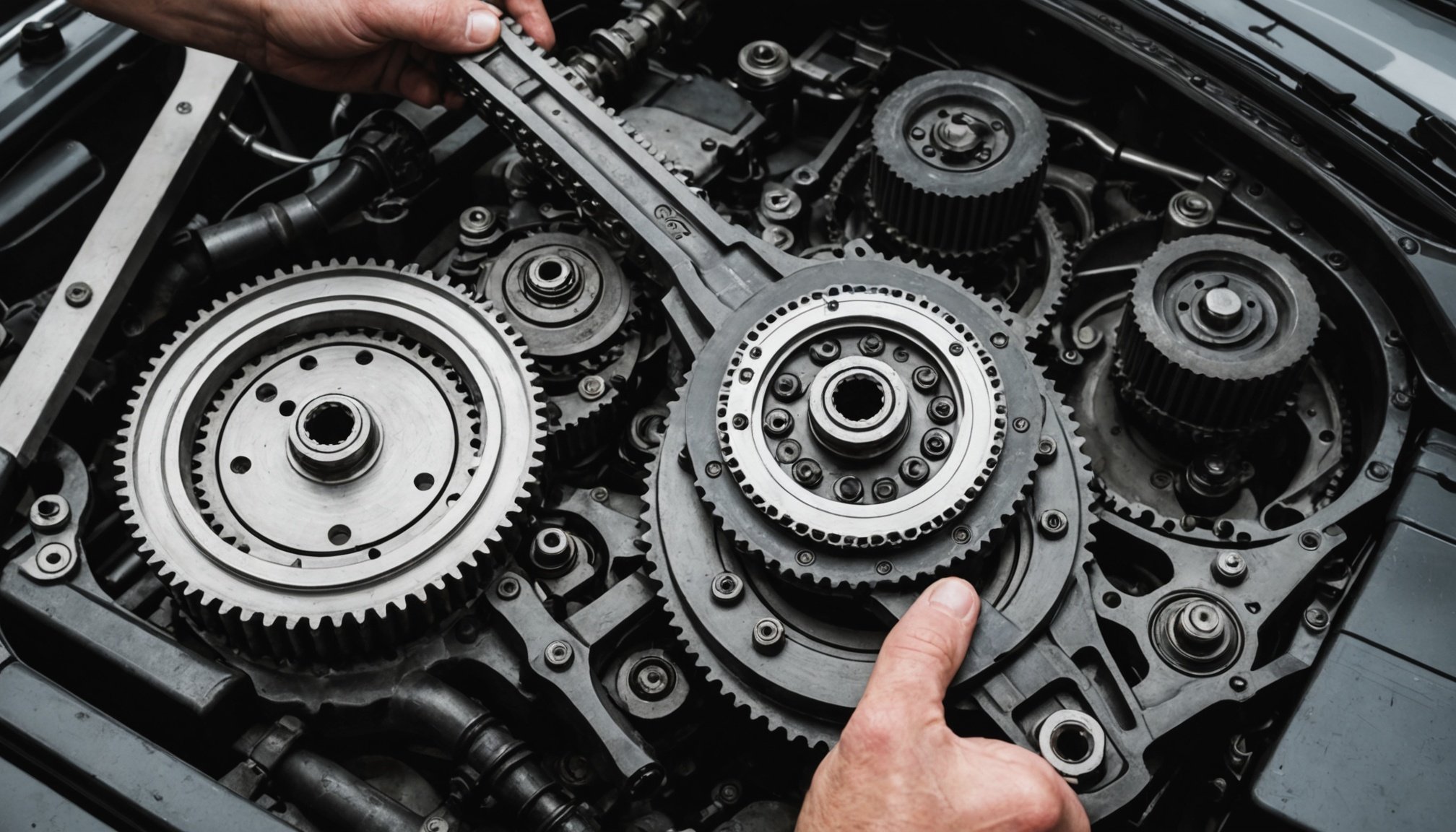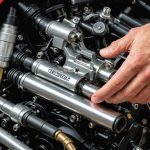The Ultimate Handbook for Assessing and Renewing Timing Chains in High-Performance Vehicles in the UK
Understanding the Importance of Timing Chains
When it comes to high-performance vehicles, the timing chain is a crucial component that ensures the engine runs smoothly and efficiently. A timing chain, also known as a cam chain, is a metal component that connects the crankshaft and the camshaft, synchronizing their rotation to ensure that the engine’s valves open and close at the correct times relative to the pistons[4].
“The timing chain is a vital part of the engine’s operation, and its failure can have catastrophic consequences,” explains a seasoned mechanic. “It’s not just about the chain itself, but also about the other components it interacts with, such as the tensioner, idler pulleys, and water pump.”
Have you seen this : Mastering sunroof care: key maintenance tips for peak vehicle performance
Types of Timing Systems
There are generally two types of timing systems used in modern engines: timing belts and timing chains.
Timing Belts
Timing belts, often referred to as cambelts, are made of rubber with teeth that mesh with the gears on the crankshaft and camshaft. They are lighter, quieter, and require less power than timing chains. However, they need to be replaced at specific intervals, typically between 60,000 to 100,000 miles, depending on the manufacturer’s recommendations[2].
In the same genre : Essential tips for a safe and reliable dual battery system installation in your camping vehicle
Timing Chains
Timing chains, on the other hand, are metal chains that have become more common since the 1990s due to their longer lifespan and reduced maintenance needs. Unlike timing belts, chains do not need to be replaced at regular intervals but can still fail due to wear on the tensioner, guides, and other associated components[2].
Assessment Process for Timing Chains
Assessing the condition of a timing chain is a critical process that requires careful attention to detail.
Visual Inspection
- Check for Wear: Look for signs of wear on the chain and its components. Check the chain for any stretching or corrosion.
- Listen for Noises: A rattling or clunking noise from the front of the engine can indicate a worn-out timing chain or its components[2].
Technical Checks
- Tensioner Check: Ensure the tensioner is functioning correctly. A faulty tensioner can cause the chain to derail or wear out prematurely.
- Guide and Idler Pulleys: Inspect these components for any signs of wear or damage. Replace them if necessary.
- Chain Guides: Check the chain guides for any signs of wear or misalignment.
Performance Monitoring
- Engine Codes: Modern vehicles with Variable Valve Timing (VVT) applications will generate engine codes and trigger the check engine light if the timing chain system is failing[2].
Practical Guidance for Renewal
Renewing a timing chain is a complex process that requires careful planning and execution.
Preparing for the Job
- Gather Tools and Parts: Ensure you have all the necessary tools and replacement parts, including the timing chain, tensioner, guides, and idler pulleys.
- Consult the Manual: Refer to the vehicle’s service manual for specific instructions and guidelines.
Step-by-Step Process
- Drain the Cooling System: If the timing chain drives the water pump, you’ll need to drain the cooling system to avoid any leaks.
- Remove the Timing Cover: This will give you access to the timing chain and its components.
- Mark the Position: Mark the position of the chain and gears to ensure correct reassembly.
- Remove the Chain: Carefully remove the timing chain and its components.
- Install New Components: Install the new timing chain, tensioner, guides, and idler pulleys.
- Reassemble: Reassemble the timing cover and refill the cooling system if necessary.
Economic and Social Benefits of Regular Maintenance
Regular maintenance of the timing chain is not just about preventing engine failure; it also has economic and social benefits.
Cost Benefits
- Preventive Maintenance: Replacing the timing chain and its components at the recommended intervals can save you from the high costs associated with engine failure.
- Fuel Efficiency: A well-maintained timing chain ensures the engine runs efficiently, which can lead to better fuel economy and reduced fuel costs.
Social Impact
- Public Safety: A failed timing chain can lead to engine failure, which can cause accidents and pose a risk to public safety.
- Environmental Impact: Efficient engine operation reduces emissions, contributing to a greener environment and aligning with the UK’s net zero goals.
Strategic Risk Management
Managing the risk associated with timing chain failure is a strategic decision that involves several factors.
Risk Assessment
- Identify Risks: Identify the risks associated with timing chain failure, including engine damage, accidents, and environmental impact.
- Mitigation Strategies: Develop strategies to mitigate these risks, such as regular inspections and replacements.
Decision Making
- Senior Managers: Senior managers in both the public and private sectors should prioritize regular maintenance as part of their strategic policy.
- Business Case: Building a strong business case for regular maintenance involves highlighting the long-term costs benefits and the value for money in preventing catastrophic failures.
Public Sector and Private Sector Applications
Both the public sector and private sector have roles to play in ensuring the proper maintenance of timing chains.
Public Sector
- Government Guidance: The government can provide guidance and regulations to ensure that vehicles are maintained properly. For example, the UK government’s roadworthiness inspections can include checks on the timing chain system[5].
- Public Service: Public service vehicles, such as buses and emergency vehicles, require stringent maintenance schedules to ensure public safety.
Private Sector
- Investment Firms: Investment firms can support businesses in the automotive sector by providing funding for maintenance and repair services.
- Business Case: Private sector businesses can build a strong business case for regular maintenance by highlighting the economic benefits and the long-term value of preventive maintenance.
Annex: Comparative Table of Timing Belts and Timing Chains
| Feature | Timing Belts | Timing Chains |
|---|---|---|
| Material | Rubber with teeth | Metal chain |
| Maintenance | Needs regular replacement | Minimal maintenance, but components can fail |
| Noise | Quieter | Can produce rattling noise when worn |
| Weight | Lighter | Heavier |
| Power Requirement | Less power required | More power required |
| Lubrication | Does not require lubrication | Requires lubrication |
| Failure Mode | Stripped teeth, delamination | Stretching, wear on components |
| Cost | Less expensive initially | More expensive initially, but longer lifespan |
Assessing and renewing timing chains in high-performance vehicles is a critical process that requires careful attention to detail and a strategic approach. By understanding the importance of timing chains, following a thorough assessment process, and adhering to practical guidance for renewal, vehicle owners and mechanics can ensure the long-term reliability and efficiency of their engines.
In the words of Steve Carolan, Dayco’s national sales manager, “Regular maintenance is key to maintaining the performance and efficiency of these engines. It’s not just about the belt or chain; it’s about the entire system and how it interacts with other components.”
By prioritizing regular maintenance, we can ensure economic benefits, public safety, and a reduced environmental impact, aligning with the UK’s strategic policy goals and the principles of good governance in both the public and private sectors.











